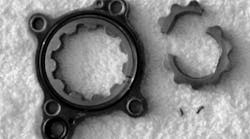The Old Timer of Royal Oak, Mich., was a regular contributor to H&P years before we ever even heard of the internet. But most of his advice is just as useful — and interesting — today.
So rather than leave his wisdom printed on pages archived in our storage room, I pulled out issues from the late 1980s and early 1990s and have been reproducing relevant entries in this blog. Here is my 22nd entry, which was originally published in the October 1989 issue:
Don’t let your pump go to pieces
Rugged hydraulic pumps usually will continue to perform fairly satisfactorily even when they begin a failure mode, but don’t wait until they fail completely before changing them. Catastrophic failure of the pumping elements can introduce thousands of metal bits and pieces into the system that will cause many future problems.
How do you know that a pump is failing when it’s still operating pretty well? There are lots of ways:
- Listen — If the usual noise level becomes higher and more pronounced, trouble is on the way. Knocks, raps, thumps, and pounding indicate that something is loose. If the noise resembles a coffee grinder, the end is near. A vane pump going bad may sound like a hacksaw cutting through sheet metal. Noise adjacent to the pump sound mean misalignment or bad bearings.
- Smell — Some fluids develop a particular odor—or may change color—when exposed to high temperature in a hot-running or by-passing pump.
- Touch —You may be able to feel excessive vibration and you’ll probably be able to feel excessive heat. If the pump is inaccessible, temperature-indicating crayon marks can help to monitor it. The reservoir is another place to check for hot fluid.
- Talk to operators —They may have noticed something different about machine operation. A slow-down in cycle time particularly indicates that the pump output has decreased. Don’t depend completely on the operator however; very gradual changes may not have registered.
- Use instrumentation — If your budget allows and you can arrange to monitor it, instrumentation will provide some positive checks on pump condition. A simple pressure gauge in the pump drain line will indicate surges or increases that signify trouble. Temperature probes can be used on both pump and motor to see if they’re running hot. An infrared probe can do this from a remote location. Again, the reservoir is a convenient location for a temperature gauge. Pressure transducers hooked to a plotter provide handy records. And finally, a frequency analyzer is a costly but useful instrument to check any rotating devices.
In the end, every piece of equipment is different and you have to develop your own sense of what is normal and what is wrong. Good records will help by telling you how long components usually last on particular applications. (Some plants can afford to change pumps and motors on a routine basis.) You have to build up your own way to evaluate systems and head off problems before they come disasters.
I actually used to tour one critical production area weekly with a tape recorder, then go to a quiet area and compare taped pump noises with those on a previous tape. I felt pretty silly when anyone found me doing this, but it worked.

